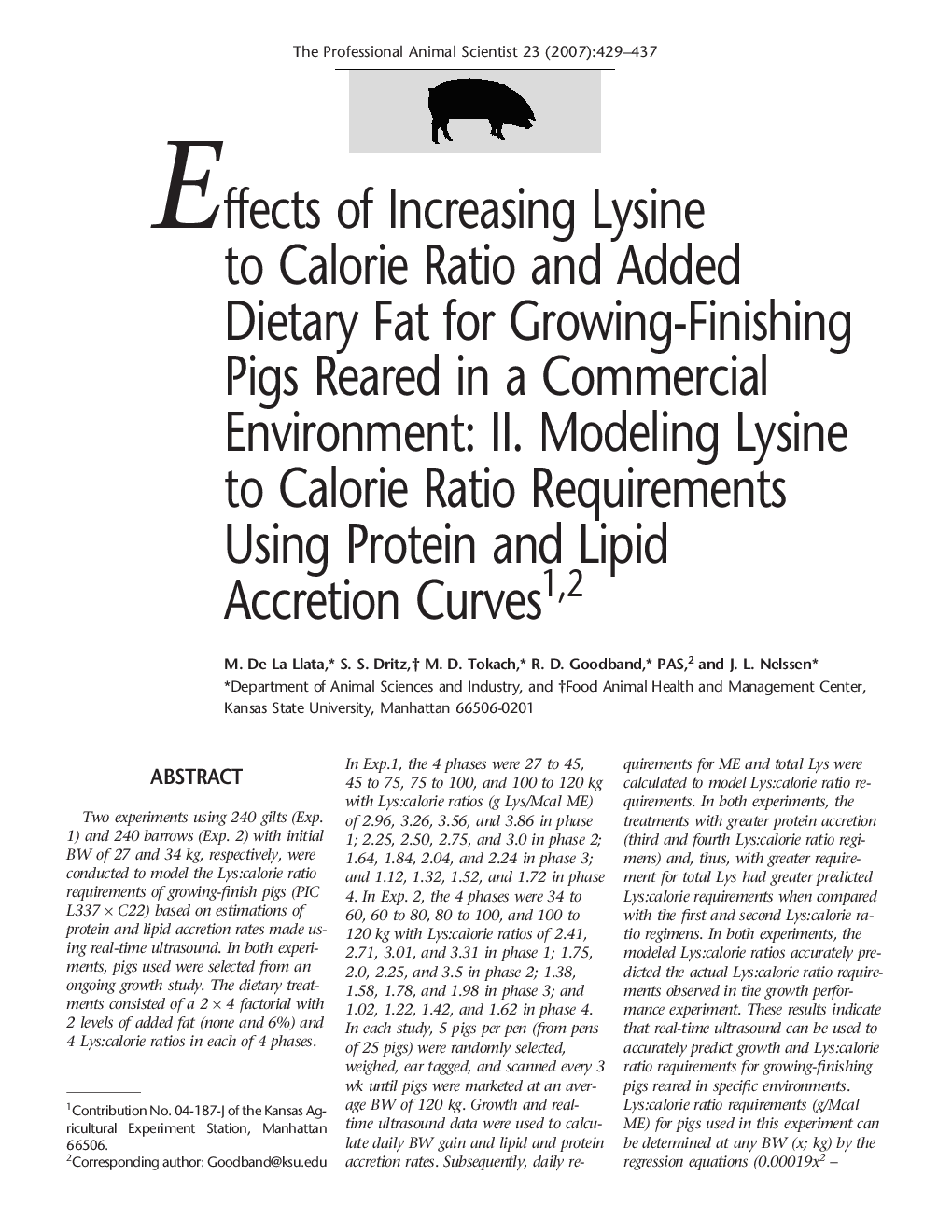| کد مقاله | کد نشریه | سال انتشار | مقاله انگلیسی | نسخه تمام متن |
|---|---|---|---|---|
| 2454641 | 1110404 | 2007 | 9 صفحه PDF | دانلود رایگان |
عنوان انگلیسی مقاله ISI
Effects of Increasing Lysine to Calorie Ratio and Added Dietary Fat for Growing-Finishing Pigs Reared in a Commercial Environment: II. Modeling Lysine to Calorie Ratio Requirements Using Protein and Lipid Accretion Curves12
دانلود مقاله + سفارش ترجمه
دانلود مقاله ISI انگلیسی
رایگان برای ایرانیان
موضوعات مرتبط
علوم زیستی و بیوفناوری
علوم کشاورزی و بیولوژیک
علوم دامی و جانورشناسی
پیش نمایش صفحه اول مقاله

چکیده انگلیسی
Two experiments using 240 gilts (Exp. 1) and 240 barrows (Exp. 2) with initial BW of 27 and 34 kg, respectively, were conducted to model the Lys:calorie ratio requirements of growing-finish pigs (PIC L337 Ã C22) based on estimations of protein and lipid accretion rates made using real-time ultrasound. In both experiments, pigs used were selected from an ongoing growth study. The dietary treatments consisted of a 2 Ã 4 factorial with 2 levels of added fat (none and 6%) and 4 Lys:calorie ratios in each of 4 phases. In Exp.1, the 4 phases were 27 to 45, 45 to 75, 75 to 100, and 100 to 120Â kg with Lys:calorie ratios (g Lys/Mcal ME) of 2.96, 3.26, 3.56, and 3.86 in phase 1; 2.25, 2.50, 2.75, and 3.0 in phase 2; 1.64, 1.84, 2.04, and 2.24 in phase 3; and 1.12, 1.32, 1.52, and 1.72 in phase 4. In Exp. 2, the 4 phases were 34 to 60, 60 to 80, 80 to 100, and 100 to 120Â kg with Lys:calorie ratios of 2.41, 2.71, 3.01, and 3.31 in phase 1; 1.75, 2.0, 2.25, and 3.5 in phase 2; 1.38, 1.58, 1.78, and 1.98 in phase 3; and 1.02, 1.22, 1.42, and 1.62 in phase 4. In each study, 5 pigs per pen (from pens of 25 pigs) were randomly selected, weighed, ear tagged, and scanned every 3 wk until pigs were marketed at an average BW of 120Â kg. Growth and real-time ultrasound data were used to calculate daily BW gain and lipid and protein accretion rates. Subsequently, daily requirements for ME and total Lys were calculated to model Lys:calorie ratio requirements. In both experiments, the treatments with greater protein accretion (third and fourth Lys:calorie ratio regimens) and, thus, with greater requirement for total Lys had greater predicted Lys:calorie requirements when compared with the first and second Lys:calorie ratio regimens. In both experiments, the modeled Lys:calorie ratios accurately predicted the actual Lys:calorie ratio requirements observed in the growth performance experiment. These results indicate that real-time ultrasound can be used to accurately predict growth and Lys:calorie ratio requirements for growing-finishing pigs reared in specific environments. Lys:calorie ratio requirements (g/Mcal ME) for pigs used in this experiment can be determined at any BW (x; kg) by the regression equations (0.00019x2 - 0.05635x + 5.499) for gilts, and (0.000049x2 - 0.037319x + 4.929) for barrows.
ناشر
Database: Elsevier - ScienceDirect (ساینس دایرکت)
Journal: The Professional Animal Scientist - Volume 23, Issue 4, August 2007, Pages 429-437
Journal: The Professional Animal Scientist - Volume 23, Issue 4, August 2007, Pages 429-437
نویسندگان
M. De La Llata, S.S. Dritz, M.D. Tokach, R.D. PAS, J.L. Nelssen,